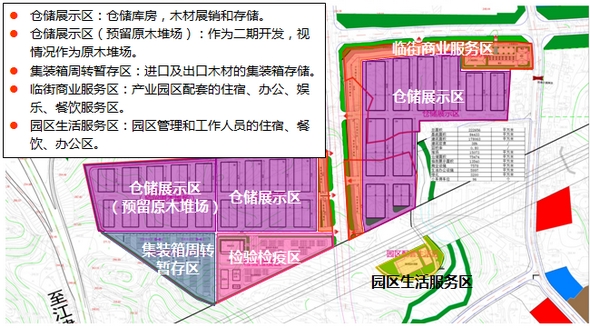





The planning of Chongqing Yongchuan Inbound timber Logistics Industrial Park project undertaken by Fablog has been completed. The project has been highly recognized by the contractor and regional leaders and has entered the construction stage.
Background of the project:
As the world's largest timber importing country, the huge demand of construction, home improvement, furniture, building materials and other industries has caused China's imported timber to account for an increasing proportion of total domestic timber consumption. With the expansion of natural forest protection projects throughout China, the commercial logging of natural forests nationwide has ceased, and the status of imported timber has become increasingly important.
Driven by national top-level strategies such as the national Belt and Road development strategy, the Yangtze River Economic Belt development strategy, and the urbanization development strategy, compared to the eastern region, urbanization and infrastructure construction in the western region will show long-term growth in the future. The demand for wood will also maintain a strong growth trend. At the same time, thanks to the promotion of the national belt and road strategy, the normal operation of the China-Europe Railway has brought greater convenience to the timber import channels in the western region. At present, Wuhan, Hubei, Ganzhou, Chongqing, Sichuan and Chengdu along the Belt and Road and cities along the Yangtze River Economic Belt are all in the process of building entry timber ports.
As the largest urban agglomeration in the western region, the Chengdu-Chongqing region is also the region with the highest basic investment density in the western region. The demand for imported timber is huge. The project is located in Yongchuan District, Chongqing. The project site is 56km away from Chongqing's nine main cities in the east and 276km away from Chengdu in the west. It connects the Sichuan Basin to the west and Chongqing's main urban area to the east. Zigong, Guiyang, Chengdu, Chongqing and other major cities in the Sichuan-Chongqing region; meanwhile, Yongchuan is also an important node for shipping in the upper reaches of the Yangtze River; it has good regional transportation advantages.
Project positioning:
Through the preliminary investigation of Chengdu Furniture Factory, Chengdu Timber Market, Chengdu Timber Processing Factory, Chongqing Timber Market, Chongqing Port, Chongqing Timber Processing Factory, Taicang Port Timber Import Port, Taicang Port Timber Market, Shanghai Furen Group, Shanghai Timber Market The Fablog project team systematically analyzed the characteristics of timber demand from the furniture and infrastructure industries in Chengdu and Chongqing, the characteristics of the circulation of imported timber markets in Chengdu and Chongqing, the pain points of the current inbound timber circulation, and the advantages of Yangtze River shipping in the distribution of timber. Disadvantages, inbound timber resources and logistics resources of the contractor, and the current situation of competition in the existing timber markets in Chengdu and Chongqing, the "relying on the resources of the Zhuhai Town terminal in Yongchuan District, Chongqing, to give full play to the advantages of the project's river-sea combined transport; facing the southwest infrastructure belt The broad timber demand market in the future is mainly coniferous forest imports from Canada, the United States and New Zealand, supplemented by the import of broad-leaved forests from Africa and Southeast Asia. The focus is on radiation of the construction timber market in Chongqing and southern Sichuan, and the furniture timber market in Chengdu. ; Combine the current "Internet +" and other industry development trends to create a large-scale "Accurate positioning of incoming timber distribution centers".
Project function system:
The functional system of the project includes three supporting platforms: “industrial facilities platform, logistics financial platform, and information trading platform” and “timber service function, logistics service function, value-added service function, and supporting service function”.
1. Timber service functions: timber storage, timber display transaction, wooden product display transaction, wood processing, and wood product processing.
2. Logistics service functions: logistics distribution, logistics loading and unloading, logistics delivery.
3. Value-added service functions: financial services, electronic transactions, and information traceability.
4. Supporting service functions: living services, customs declaration and inspection, office R & D, etc.
Project functional partition:
Based on the project's functional positioning and the specific conditions of the construction site, Fablog planned the industrial park as a "storage display area, storage display area (raw log yard), container turnover temporary storage area, street commercial service area, and park life service area. "Five functional areas.
1. Warehouse display area: storage warehouse, wood exhibition and storage.
2. Warehouse display area (reserved log yard): log yard.
3. Container turnover temporary storage area: Container storage for imported and exported timber.
4. Commercial service area facing the street: accommodation, office, entertainment, catering service areas supporting the industrial park.
Park life service area: park management and staff accommodation, catering, office area.